What's The Difference Between High Bay And Low Bay Lights?
When it comes to industrial and commercial lighting, high bay and low bay lights are two of the most common solutions. The choice between them depends largely on ceiling height and lighting requirements. Understanding the difference helps facility managers and buyers select the right product for their application. With our advanced LED High Bay Lights, we provide superior performance designed for large-scale environments.
Key Differences Between High Bay and Low Bay Lights
1. Installation Height
High Bay Lights: Designed for ceilings above 20 feet (6 meters), often up to 40 feet or more. They deliver strong, concentrated light to ensure brightness reaches the floor and work areas effectively.
Low Bay Lights: Installed in ceilings below 20 feet (6 meters), providing softer illumination suitable for smaller commercial or residential spaces.
2. Light Distribution
High Bay: Use special optics, reflectors, or lenses to distribute light uniformly across a wide area. This avoids shadows and ensures consistent visibility in large warehouses, factories, or sports arenas.
Low Bay: Light is less focused, spreading naturally in smaller spaces like retail stores or workshops.
3. Brightness and Wattage
High Bay: Typically ranges from 100W to 300W, producing high lumen output that can exceed 100–110 LM/W depending on the model.
Low Bay: Operates at lower wattages, usually 60W to 100W, as less light is needed for low-ceiling areas.
4. Durability and Application
High Bay: Built with robust die-cast aluminum housings, advanced heat dissipation, and IP65 waterproof and dustproof protection. They are ideal for challenging environments where reliability is critical.
Low Bay: More lightweight, suitable for less demanding environments, but may not withstand dust, moisture, or extreme temperatures as effectively.
Advantages of Our High Bay Lights
Our LED high bay lights are engineered for maximum efficiency, safety, and long-term performance. Compared with standard low bay solutions, our products offer clear advantages:
High-Quality LEDs
Equipped with 2835 SMD high lumen chips, our fixtures provide brightness levels up to 110 LM/W, ensuring superior light transmittance and energy savings.Excellent Heat Dissipation
Using high-grade aluminum die-casting bodies, our luminaires guarantee stable operation and extend lifespan, even in high-demand industrial environments.IP65 Protection
Waterproof and dustproof design makes our lights suitable for both indoor and outdoor use, offering reliable performance in warehouses, logistics centers, and manufacturing plants.Safety and Stability
With a power factor above 0.9, anti-surge protection (3.5KV), and wide operating temperature from -30°C to +50°C, our high bay lights remain stable under varied electrical and environmental conditions.Long Service Life
Designed for up to 30,000 hours of operation, minimizing replacement and maintenance costs.Modern and Practical Design
Compact UFO style ensures easy installation, low maintenance, and cost savings in shipping and logistics. This makes our lights highly competitive in global markets.
Conclusion
The main difference between high bay and low bay lights lies in ceiling height, brightness, and durability requirements. While low bay lights work well in small or medium-height spaces, high bay lights are essential for tall, expansive areas that demand powerful and uniform illumination.
Our LED high bay lights not only meet but exceed these requirements, offering high efficiency, IP65 protection, and a long lifespan, making them the preferred choice for industrial and commercial projects worldwide.




